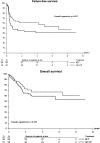A randomized phase III study comparing standard dose BEP with sequential high-dose cisplatin, etoposide, and ifosfamide (VIP) plus stem-cell support in males with poor-prognosis germ-cell cancer. An intergroup study of EORTC, GTCSG, and Grupo Germinal (EORTC 30974)
- PMID: 21059637
- PMCID: PMC3082158
- DOI: 10.1093/annonc/mdq575
A randomized phase III study comparing standard dose BEP with sequential high-dose cisplatin, etoposide, and ifosfamide (VIP) plus stem-cell support in males with poor-prognosis germ-cell cancer. An intergroup study of EORTC, GTCSG, and Grupo Germinal (EORTC 30974)
Abstract
Background: To compare the efficacy of one cycle of standard dose cisplatin, etoposide, and ifosfamide (VIP) plus three cycles of high-dose VIP followed by stem-cell infusion [high-dose chemotherapy (HD-CT arm)] to four cycles of standard cisplatin, etoposide, and bleomycin (BEP) in patients with poor-prognosis germ-cell cancer (GCC).
Patient and methods: Patients with poor-prognosis GCC were assigned to receive either BEP or VIP followed by HD-CT. To show a 15% improvement in a 1-year failure-free survival (FFS), the study aimed to recruit 222 patients but closed with 137, due to slow accrual.
Results: One hundred thirty-one patients were included in this analysis. The complete response rates in the HD-CT and in the BEP arm did not differ: (intention to treat) 44.6% versus 33.3% (P = 0.18). There was no difference in FFS between the two treatment arms (P = 0.057, 66 events). At 2 years, the FFS rate was 44.8% [95% confidence interval (CI) 32.5-56.4] and 58.2%, respectively (95% CI 48.0-71.9); but this 16.3% (standard deviation 7.5%) difference was not statistically significant (P = 0.060). Overall survival did not differ between the two groups (log-rank P > 0.1, 47 deaths).
Conclusion: This study could not demonstrate that high-dose chemotherapy given as part of first-line therapy improves outcome in patients with poor-prognosis GCC.
Figures
Similar articles
-
Personalised chemotherapy based on tumour marker decline in poor prognosis germ-cell tumours (GETUG 13): a phase 3, multicentre, randomised trial.Lancet Oncol. 2014 Dec;15(13):1442-1450. doi: 10.1016/S1470-2045(14)70490-5. Epub 2014 Nov 13. Lancet Oncol. 2014. PMID: 25456363 Free PMC article. Clinical Trial.
-
Cisplatin, etoposide and either bleomycin or ifosfamide in the treatment of disseminated germ cell tumors: final analysis of an intergroup trial.Cancer. 2003 Apr 15;97(8):1869-75. doi: 10.1002/cncr.11271. Cancer. 2003. PMID: 12673712 Clinical Trial.
-
Long-term results of first-line sequential high-dose etoposide, ifosfamide, and cisplatin chemotherapy plus autologous stem cell support for patients with advanced metastatic germ cell cancer: an extended phase I/II study of the German Testicular Cancer Study Group.J Clin Oncol. 2003 Nov 15;21(22):4083-91. doi: 10.1200/JCO.2003.09.035. Epub 2003 Oct 20. J Clin Oncol. 2003. PMID: 14568987 Clinical Trial.
-
Intensive induction chemotherapy with CBOP/BEP in patients with poor prognosis germ cell tumors.J Clin Oncol. 2003 Mar 1;21(5):871-7. doi: 10.1200/JCO.2003.05.155. J Clin Oncol. 2003. PMID: 12610187 Review.
-
High-dose chemotherapy followed by hematological support: experience in the treatment of germ cell tumors.Bull Cancer. 1995;82 Suppl 1:56s-60s. Bull Cancer. 1995. PMID: 7542945 Review.
Cited by
-
[Management of chemotherapy side effects and their long-term sequelae].Urologe A. 2021 Jul;60(7):862-871. doi: 10.1007/s00120-021-01569-7. Epub 2021 Jun 29. Urologe A. 2021. PMID: 34185118 Review. German.
-
First - line, non - cryopreserved autologous stem cell transplant for poor - risk germ - cell tumors: Experience in a developing country.Int Braz J Urol. 2019 Jan-Feb;45(1):74-82. doi: 10.1590/S1677-5538.IBJU.2017.0562. Int Braz J Urol. 2019. PMID: 30325602 Free PMC article.
-
Randomized phase III study comparing paclitaxel-bleomycin, etoposide, and cisplatin (BEP) to standard BEP in intermediate-prognosis germ-cell cancer: intergroup study EORTC 30983.J Clin Oncol. 2012 Mar 10;30(8):792-9. doi: 10.1200/JCO.2011.37.0171. Epub 2012 Jan 23. J Clin Oncol. 2012. PMID: 22271474 Free PMC article. Clinical Trial.
-
Primary intracranial germ-cell tumors in adults: a practical review.J Neurooncol. 2013 Jun;113(2):175-83. doi: 10.1007/s11060-013-1114-6. Epub 2013 Mar 23. J Neurooncol. 2013. PMID: 23526409 Review.
-
[Update on first-line and relapse chemotherapy for testicular cancer].Urologe A. 2013 Nov;52(11):1547-8, 1550-5. doi: 10.1007/s00120-013-3251-0. Urologe A. 2013. PMID: 24126502 German.
References
-
- International Germ Cell Collaborative Group. International Germ Cell Classification: a prognostic factor-based staging system for metastatic germ-cell cancers. J Clin Oncol. 1997;15:594–603. - PubMed
-
- Bokemeyer C, Schmoll HJ, Illinger HJ, et al. A phase I/II study of stepwise dose-escalet regimen of cisplatin, etoposide and ifosfamide plus granulocyte-macrophage colony-stimulating factor (GM-CSF) in patients with advanced germ cell tumours. Eur J Cancer. 1993;29:2225–2231. - PubMed
-
- Schmoll HJ, Kollmannsberger C, Metzner B, et al. Long-term results of first-line sequential high-dose etoposide, ifosfamide, and cisplatin chemotherapy plus autologous stem cell support for patients with advanced metastatic germ cell cancer: an extended phase I/II study of the German Testicular Cancer Study Group. J Clin Oncol. 2003;21:4083–4091. - PubMed
-
- Bokemeyer C, Kollmannsberger C, Meisner C, et al. First-line high-dose chemotherapy compared with standard-dose PEB/VIP chemotherapy in patients with advanced germ cell tumors: a multivariate and matched-pair analysis. J Clin Oncol. 1999;17:3450–3456. - PubMed
-
- Pocock SJ, Simon R. Sequential treatment assignment with balancing for prognostic factors in the controlled clinical trial. Biometrics. 1975;31:103–115. - PubMed
Publication types
MeSH terms
Substances
Supplementary concepts
Grants and funding
- 5U10 CA11488-32/CA/NCI NIH HHS/United States
- 5U10 CA11488-27/CA/NCI NIH HHS/United States
- 5U10 CA11488-38/CA/NCI NIH HHS/United States
- 5U10 CA11488-39/CA/NCI NIH HHS/United States
- 5U10 CA11488-28/CA/NCI NIH HHS/United States
- 5U10 CA11488-35/CA/NCI NIH HHS/United States
- 5U10 CA11488-31/CA/NCI NIH HHS/United States
- 5U10 CA11488-37/CA/NCI NIH HHS/United States
- 5U10 CA11488-29/CA/NCI NIH HHS/United States
- 5U10 CA11488-40/CA/NCI NIH HHS/United States
- 5U10 CA11488-36/CA/NCI NIH HHS/United States
- 5U10 CA11488-33/CA/NCI NIH HHS/United States
- 5U10 CA11488-34/CA/NCI NIH HHS/United States
- 5U10 CA11488-30/CA/NCI NIH HHS/United States
LinkOut - more resources
Full Text Sources
Medical



